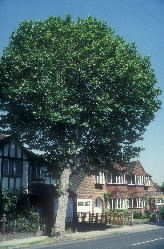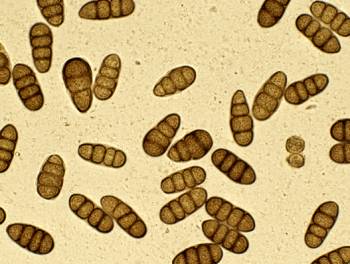Present in United Kingdom
Notifiable – see ‘Report a sighting’ below
Scientific name of causal agent – Splanchnonema platani

Massaria disease is a disease of London plane trees (Platanus x hispanica, also known as Platanus x acerifolia) which causes large lesions on the upper surfaces of major branches and branch dieback, and can cause branches to break off the tree and fall.
It is believed to be caused, at least partly, by the fungus Splanchnonema platani, which used to be known as Massaria platani. Our research suggests that other fungi species might also play a role in the extensive decay associated with the lesions.
S. platani is an ascomycete fungus whose anamorph is Macrodiplodiopsis desmazieresii.
Massaria disease and the S. platani fungus have been found in several parts of England since the early 21st century. Spores of the fungus were found on fallen, dead plane twigs at London’s Royal Botanic Gardens, Kew, in 2003, then it was found on living plane trees in London and Bristol in 2009.
It is common in warmer Mediterranean climates and the southern United States, and in Europe it has been confirmed as far north as The Netherlands.
London plane is a hybrid, and its parent species, Oriental plane (P. orientalis) and American plane (P. occidentalis), can also be infected.
It is not thought to affect tree species in any genus apart from Platanus.
London plane trees are shady, tolerate air pollution and drought, and their large, thick leaves capture particles of airborne pollution. As a result they are widely planted in British and European towns and cities as shade and amenity trees. Massaria disease can therefore be a significant public safety issue for their owners, many of which are local authorities or other public bodies. Dead branches and other dead wood must be removed before they become an unacceptable hazard.
It would be cause for concern if Massaria disease were to become so damaging, and so expensive to manage, that local authorities and other public bodies were to discontinue using plane trees in towns and cities. Urban trees are increasingly recognised as important contributors to the health and well-being of town and city dwellers, as well as providing numerous environmental benefits. Planes are well suited for the purpose, and few other species are as resilient to the challenges of life as an urban tree.
Regular monitoring of tree condition, and active management in the form of pruning affected branches, are therefore recommended. See ‘Management and control’ below.

The disease mostly affects the lower and middle-order branches of trees older than 40 years.
It first appears as a pinkish strip of dead bark on the upper surface of the branch, and develops into a lesion extending from a union with the parent branch or the stem (trunk). The width of this strip of dead bark can vary, but it nearly always tapers to a distinct point. The lesions can extend several metres, but infection can be difficult to see from the ground, particularly on larger branches, because they occur on the upper sides of the branches.
Branch decline in the summer months, particularly of smaller-diameter branches, can be an indication of infection recognisable from the ground. Young twigs, seed clusters and sometimes wilted leaves might remain on the dead branch. Dead, flaking bark is also often present, exposing the orange sapwood.
Affected branches suffer death of the bark and cambium (the layer of tissue just under the bark), which can affect up to 30 per cent of the branch circumference. Areas towards the edges of the lesions turn black when the fungus produces spores. Lesions are associated with wood decay, characterised by soft rot, often resulting in fracture and /or the death of the branch.
Arboriculturalists with London’s Royal Parks have seen branch failure as soon as three months after symptoms first become noticeable, but it more typically occurs after one or more years.
Tree stems (trunks) are not usually affected by Massaria disease. Ascomycete fungi in the genus Hapalocystis can cause similar-looking lesions and decay on plane trees, sometimes in the main stem. More research is needed to determine the distribution and potential impact of this pathogen.
In continental Europe the fungus seems to produce an abundant number of spores on the surface of the bark or cambium that surrounds the lesion. In the UK we have seen a number of samples with abundant sporulation in the autumn and winter.

These spores are easily seen under a microscope (above):
Members of the public are unlikely to see the early symptoms of S. platani infection because they occur mostly on the upper sides of branches. However, most plane trees are managed by public authorities, which should have a programme of regular tree safety inspections and preventative action.
Nevertheless, anyone who suspects they have seen signs of the disease in a plane tree, such as dieback and decline in a branch or branches, should report it to the owner, if known. If not, they may report it to the plant health authorities through the following disease reporting tools:
Please note that TreeAlert and TreeCheck both require photographs to be uploaded. These should be clear, well-lit, close-up pictures of symptoms.
S. platani spores are readily spread long distances by the wind. In one notable case, spores were collected by a survey ship stationed over the Mid-Atlantic Ridge between the Caribbean Sea and North Africa. We therefore believe it could have been spread on the wind from its Mediterranean heartland to Great Britain, although it could also be native to Great Britain.
There is no available treatment for the disease apart from removing diseased branches before they become an unacceptable safety hazard. People who work on plane trees can help to minimise the rate of spread by practising good biosecurity, or plant hygiene, such as cleaning and disinfecting tools, equipment, boots and outer clothing before working on other trees.
Guidance on biosecurity is available from the UK Government website.
The Forestry Commission commissioned surveys during 2014 of plane trees in London, and in 2015 of plane trees in other English cities, for evidence of canker stain of plane, caused by the Ceratocystis platani fungus. The surveyors also looked for evidence of Splanchnonema platani infection.
The Forestry Commission also worked to raise awareness among plane tree owners and managers of the apparently increased safety hazard associated with Massaria, and the need to monitor trees’ safety and take preventative action if the risk becomes unacceptable.
The UK has European Union Protected Zone status for plane material to provide extra safeguards against accidental introductions of the canker stain of plane fungus (C. platani) on imported plane plants or wood. This also reduces the risk of further introductions of Massaria. The legislation effectively bans the movement of plane plants into the UK unless they have been grown in an area free of plane tree wilt, and are accompanied by a plant passport certifying this.
The UK Government website has explanations of the regulations applying to the importation of:
Forest Research has isolated S. platani from the edges of branch lesions, from the decayed wood within the branches, and from twigs fallen from plane trees growing in streets and parks across Europe. Around the edges of active lesions researchers frequently find:
Molecular analyses of the 16S Nuclear Small Subunit rRNA gene and Internal Transcribed Spacer (ITS) region of the ribosomal DNA genes cluster together the isolates from the different geographic locations, suggesting they are all closely related, with no distinct British population. It is still not clear whether S. platani is native to Britain or whether it was introduced at some point from mainland Europe.
No differences have been found in isolates taken from active branch lesions or fallen twigs. Researchers have therefore not found any evidence of a separate lineage of S. platani that is more pathogenic and capable of causing the branch breakage seen in recent years.
Most S. platani isolates grew rapidly on artificial media at temperatures between 20 and 30C, meaning that the fungus will probably thrive in the increasing urban temperatures expected due to climate change.
Other fungi have also been isolated from the branch surfaces, and from within decayed wood, including opportunistic basidiomycetes such as Auricularia species and Armillaria, as well as some as-yet unidentified organisms whose role is unclear.
The S. platani fungus had long been considered a weak parasite, capable of causing only minor damage. It is frequently found on dead twigs and bark which have already been killed by other organisms or non-living causes.
However, it was found to be associated with branch death and rapid decay in mature trees in Germany during the hot, dry summer of 2003. Similar episodes followed in subsequent years in Austria, The Netherlands and France. Scientists began investigating why the fungus had become increasingly associated with more-serious symptoms such as branch decay and failure.
Then tree management teams in London, England, began to notice large lesions and branch drop on the branches of plane trees in 2009.
S. platani spores were found to be associated with the lesions. However, it is not yet fully clear whether this is the primary cause of the branch decay and death.
The fungus used to be known as Massaria platani, which gave rise to the common name of the disease which it causes, until a taxonomic revision resulted in a name change. However, Massaria disease of plane continues to be recognised as the common name of the disease.